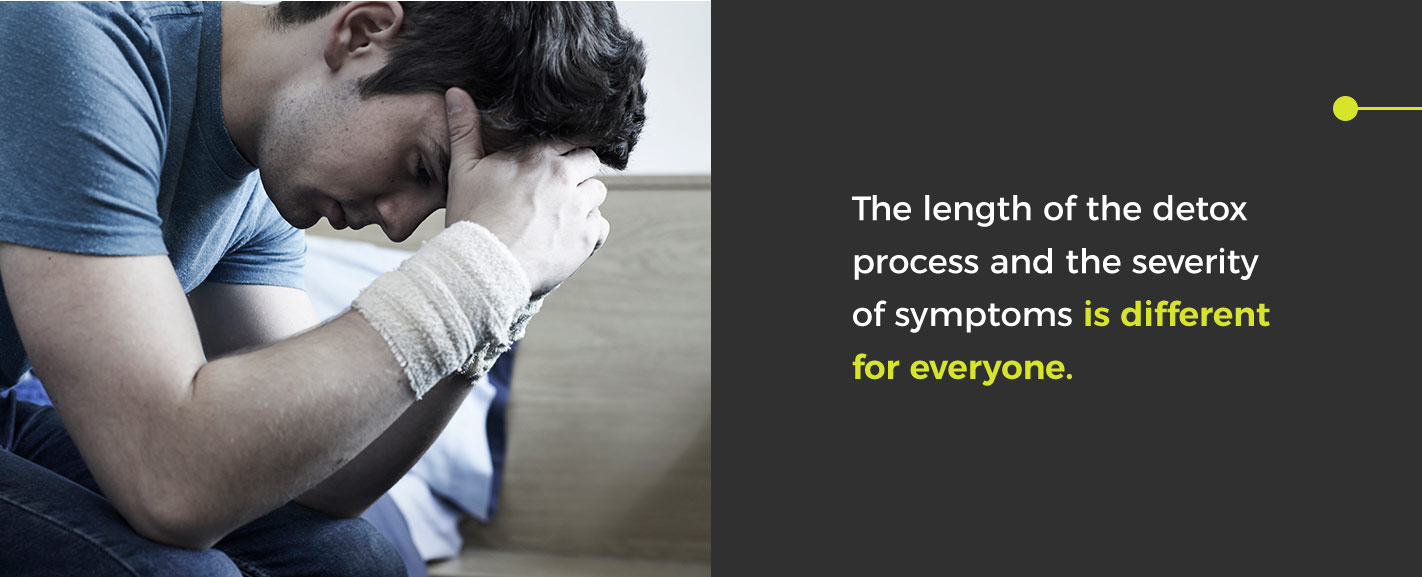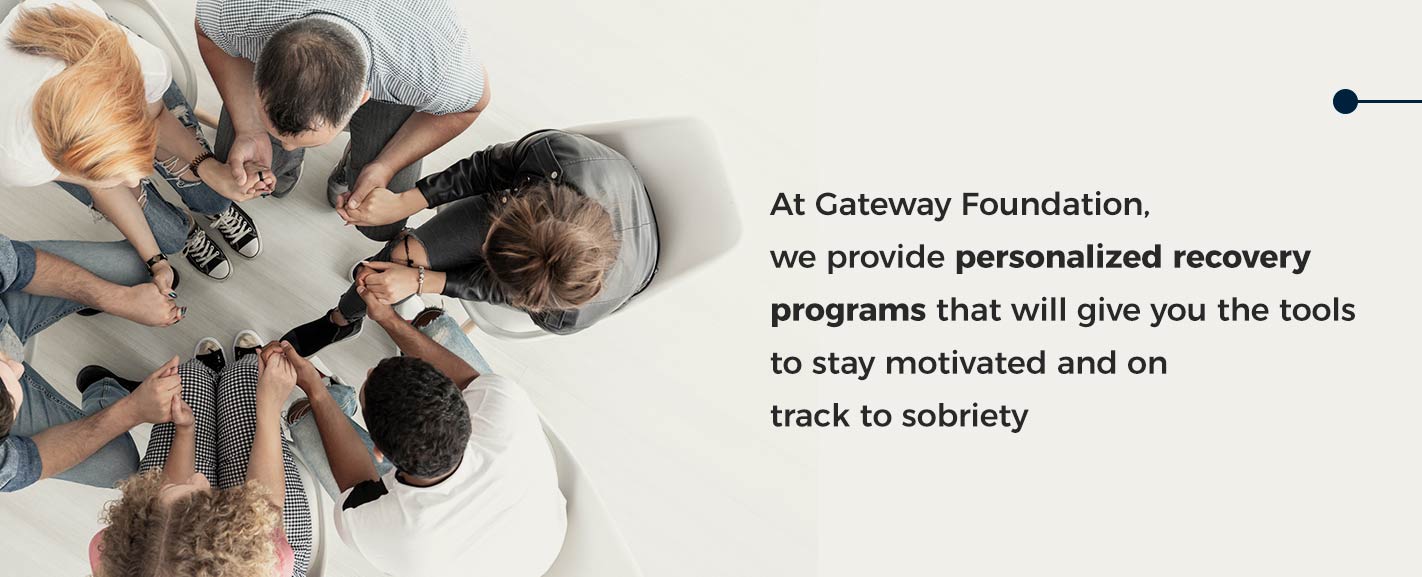- Jan 24
- Alcohol Addiction TreatmentTreatment
The amount of time it takes to fully detox from alcohol consumption varies from person to person. The detox process can last from a few days to a few weeks, but the length of the process depends on the individual. Moderate alcohol withdrawal symptoms can even last for a month in rare cases, and some symptoms can come and go over the course of a couple of years. Treatment can make the detox process more comfortable and manageable for people struggling with a substance use disorder. The symptoms of withdrawal can seem intimidating at first, but support from professionals in a treatment facility can manage withdrawal symptoms and help people through the detox process so they can begin recovery and get back to living their lives.
- Alcohol Detox Timeline
- Factors That Affect the Alcohol Detox Timeline
- Symptoms You’ll Experience During Detox
- How Treatment Helps
- Take the First Step Toward Recovery
Alcohol Detox Timeline
During the detoxification process, the body metabolizes remaining alcohol out of its system following a person’s last drink. It is the first stage of recovery from substance use disorder, and it allows a person to begin treatment safely and comfortably with a clear system. The timeline of alcohol detox is different for everyone, but the following is an overview of what people usually experience when they go through withdrawal:
6-12 hours
Mild withdrawal symptoms will usually begin six hours after a person who suffers from substance use disorder has their last drink. One of the first symptoms an individual will experience is cravings. During this time, they might also experience:
- Nausea
- Upset stomach
- Low appetite
- Depression
- Headaches
- Nightmares
- Insomnia
- Tremors
After six hours, the individual can also have seizures if they have a long history of heavy alcohol use. Doctors consider seizures to be the most dangerous of acute alcohol withdrawal symptoms.
12-24 hours
After 12 hours, people will begin to experience moderate withdrawal symptoms. Research has found 2-8% of people experience hallucinations as they go through alcohol withdrawal. They might see or hear things that aren’t physically there and feel scared, but doctors don’t consider this to be a serious complication. These symptoms will typically peak at 18-24 hours and decrease after four or five days for people going through minor withdrawal.
24-48 hours
During this time, people will usually continue to experience mild to moderate withdrawal symptoms. The risk of experiencing a seizure peaks at this time and can remain high for several days. Seizures can be mild, but they can also lead to life-threatening conditions.
48-72 hours
After 48 hours, people may experience more severe withdrawal symptoms. Some people may experience alcohol withdrawal delirium, also known as delirium tremens (DTs). This is a severe form of alcohol withdrawal that can cause:
- Body tremors
- Agitation or irritability
- Sweating
- Extreme confusion or disorientation
- Rapid mood changes
- Hallucinations
- Fever
- Increased heart rate
- Seizures
An increase in blood pressure can also occur and lead to chest pain. The risk for seizures decreases after 48 hours in most cases, but the risk of heart attack and stroke increases. DT has a high death rate, so it is usually monitored and treated in a hospital’s intensive care unit with supervision, sedating medications and medical care.
72+ hours
People going through alcohol withdrawal will usually experience their worst symptoms during this time period. DTs may last two to three days, but can continue past eight days and can lead to death if a medical professional does not monitor and manage the symptoms. It is critical to seek medical attention if symptoms are severe.
Factors That Affect the Alcohol Detox Timeline
The length of the detox process and the severity of symptoms is different for everyone. People can experience alcohol withdrawal symptoms whether they have been drinking for weeks, months or years. However, the length of the detox process largely depends on how long the individual has been drinking alcohol and the severity of alcohol consumption.
Length of Addiction
A person who drinks alcohol for multiple years will experience detox symptoms longer than a person who drinks alcohol for a few months, and professionals recommend medically assisted detox if the individual has a longer history of drinking alcohol. Individuals who start drinking at age 17 or younger are at a higher risk of experiencing hallucinations during the detox process and might experience withdrawal symptoms longer.
Someone who has been drinking alcohol for a longer period of time has a higher risk of experiencing DTs when they begin to detox. Research shows about 3%-5% of people hospitalized for alcohol detox treatment experience DTs. Symptoms of DTs usually start about three days after the beginning of detox and last two to three days, but they can last eight or more days based on the severity of withdrawal.
The way a person goes through detox can also affect the timeline of withdrawal. If a person quits alcohol cold turkey, or all at once, they will usually go through withdrawal faster. However, it can also be dangerous to quit cold turkey in some cases. This depends on the level of alcohol consumption as well as the amount of time the individual has had the substance use disorder.
Level of Addiction
The more severe a person’s substance use disorder is, the longer their detox process will last. People will typically begin to experience alcohol detox symptoms within six to eight hours after their last drink if their use of alcohol was mild or moderate, and their symptoms will usually last five to seven days. However, people who drink higher amounts of alcohol more often will usually experience symptoms for two weeks or more.
The length of the detox process also depends on how much alcohol a person drinks before starting to detox and how frequently they drink alcohol. The detox process can be different for people who binge drink than it is for people who drink regularly at a steady pace. The Prediction of Alcohol Withdrawal Severity Scale (PAWSS) is a scale doctors use to determine if patients are at risk of experiencing severe withdrawal symptoms. The PAWSS scale accounts for the blood alcohol level of an individual as well as other factors, including when the person was last intoxicated, if they have experienced blackouts and if they have combined alcohol with other harmful substances. If an individual combines alcohol with other substances, the detox process might last longer with more severe symptoms.
The severity of alcohol withdrawal symptoms can also depend on personal habits and physical factors such as age, weight, biological sex, mental health, overall physical health, genetic factors and other drug use. Older individuals will usually experience more severe symptoms than younger individuals, as will individuals with poor physical or mental health. While these factors can play a part in a person’s recovery, the severity and length of the detox process largely depend on the amount of alcohol an individual drinks, how often they drink and how long they have been drinking.
Symptoms You’ll Experience During Detox
Research has estimated 50% of people with a substance use disorder will experience withdrawal symptoms, and one-third of people will experience moderate or severe withdrawal symptoms. When a person stops drinking, their body, brain, blood levels and neurotransmitters go into shock because the alcohol they have become dependent on is no longer in their system. Their nervous system becomes overactive, which can lead to various symptoms.
Mild Alcohol Withdrawal Symptoms
Mild alcohol withdrawal symptoms include sweating, anxiety and depression, nausea, low appetite and headaches. Three-quarters of people recovering from alcohol use will also experience post-acute withdrawal syndrome (PAWS). Symptoms are mainly psychological and affect sleep patterns, mood and responses to stress. These symptoms occur after the detox process, last for about two years and can come and go for a few days at a time.
Dangerous Withdrawal Symptoms
In cases where a person has a history of heavy or extensive alcohol use, rapid heart rate, or tachycardia, is possible. In some cases of tachycardia, a person might experience little to no symptoms. However, if it is left untreated, it can lead to more serious issues such as stroke, sudden cardiac arrest, heart failure or death.
Tonic-clonic seizures are common in cases of severe alcohol withdrawal, and they cause both stiffening and jerking or twitching phases of muscle movement. This type of seizure can cause abnormal sensations, nausea, vertigo, loss of consciousness and impaired breathing. Tonic-clonic seizures that are untreated can lead to delirium tremens.
A person going through severe withdrawal who experiences DTs will also experience symptoms such as high body temperature, paranoia, hallucinations and seizures. When people experience DTs without medical intervention the mortality rate is 20%, most commonly due to respiratory collapse, cardiac arrhythmias or infection. Extended symptoms, including fatigue, sleep disturbances and mood changes, can last for months.
How Treatment Helps
Researches have found that people will have an increased chance of successful treatment if they undergo alcohol detoxification with the help of a medical professional. In some cases of detox, professional medical monitoring is necessary to treat life-threatening symptoms as the process progresses. For milder cases of detox, treatment can ease alcohol withdrawal symptoms so patients can focus on recovering.
Physical Health and Safety During Detox
Mild to moderate symptoms of alcohol withdrawal can be treated on an inpatient or outpatient basis, but it’s essential to have professional supervision during detox to monitor for potentially severe symptoms. Severe symptoms may also require management in a medical setting. During treatment, professionals can observe individuals at the start of treatment to determine the severity of symptoms, and they can continue to monitor individuals for any problems that may arise during detox. In addition to observations, medical professionals can provide patients with medications to reduce cravings and ease symptoms through the detox process. Beta-blockers can reduce tremors, slow the heart rate and reduce alcohol cravings. Anti-seizure and anti-anxiety medications can help patients avoid or reduce seizures and anxiety. The use of medication-assisted treatment can also help reduce the risk of relapse as well as the need for hospitalization.
People with substance use disorder should seek medical care immediately if they experience fever, nausea or abnormal breathing. In addition, individuals who are older or have a history of seizures, liver problems or other drug use should seek medical supervision when they begin to detox. Individuals may need close monitoring and seizure prophylaxis when the risk for seizure is increased. In these cases, treatment is necessary for an individual’s safety. However, treatment can increase the chance of a successful recovery for any individual regardless of how severe their symptoms are.
Positive Outcomes After Detox
People are more likely to experience a safe and successful recovery when compassionate professionals support them through the detox process. Treatment offers individuals the mental and physical support they need to detox safely and continue their recovery afterward. Professionals can use methods such as cognitive behavioral therapy (CBT) and dialectical behavior therapy (DBT) to help individuals focus on changing their thinking and behaviors to manage emotions better.
Professionals also walk people through methods such as motivational interviewing and acceptance and commitment therapy to help them accept their situations and stay motivated in recovery. Mindfulness-based sobriety treatment keeps people focused on the present rather than dwelling on the past or worrying about the future, which is another method that helps them achieve a successful recovery. Treatment aids people in all areas of recovery so that they can get back to focusing on their well-being as well as their families, friends, communities and jobs. It offers people the support, safety, motivation and accountability to have a positive outcome after detox.
Take the First Step Toward Recovery
Your life is worth recovering for, and you can get through the detox process. The detox process can last anywhere from a few days to a couple of months, so it’s important to have the support you need to achieve the best results. The length of the detox process will depend on multiple factors, but it’s vital to seek medical and professional supervision during this process to maintain health, safety and an increased chance for a successful recovery.
Gateway Foundation will work with you to create a personalized treatment plan and support you every step of the way. Whether you need to undergo outpatient therapy to meet outside obligations like work and family, or you need inpatient treatment for close monitoring, Gateway Foundation will help you find freedom from alcohol addiction and get back to living your life. With over 50 years of evidence-based treatments, positive outcomes, caring staff members and multiple sites that will work with your insurance network, Gateway Foundation will be with you for life. Take the first step and reach out to us today to begin your recovery journey.






